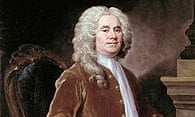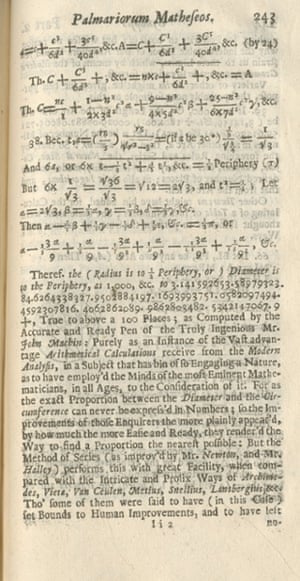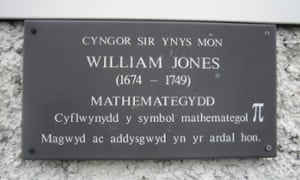3月14日被定為「圓周率日」(Pi day),這天同時也是阿爾伯特‧愛因斯坦的生日(Albert Einstein,1879年3月14日-1955年4月18日)。
【文化】白色情人節
「加倍奉還的情人節回禮」
2月14日情人節當天,女生會送給男生巧克力,今天3月14日是男生向女生回禮的「白色情人節」對於因為情人節關係變得樂觀的情侶們來說,今天是非常令人期待又興奮的一天(≧∇≦)
照片是位於箱根玻璃森林的「水晶愛之樹」,在這天也是熱門的約會地點。
大家是否知道類似日本白色情人節一樣充滿幸福文化跟節日呢?請留言與我們分享哦(*´∀`*)
2月14日情人節當天,女生會送給男生巧克力,今天3月14日是男生向女生回禮的「白色情人節」對於因為情人節關係變得樂觀的情侶們來說,今天是非常令人期待又興奮的一天(≧∇≦)
照片是位於箱根玻璃森林的「水晶愛之樹」,在這天也是熱門的約會地點。
大家是否知道類似日本白色情人節一樣充滿幸福文化跟節日呢?請留言與我們分享哦(*´∀`*)
《沉思的阿基米德》,費地(1620)
「事實上,受過良好教育的上流社會人士都知道,沒有一個圓形是真正的圓形,他們只是有著無限多無線短邊的多邊形。多邊形的邊數增加到最後,即會趨近於圓形。當邊數多到一定程度時,好比說三百到四百,即使是最精巧的觸覺辨認,也難以分辨出多邊形的角度。」
-摘自《平面國:向上,而非向北!》http://ppt.cc/TNKE
不像三角形、正方形、多邊形有直線邊能計算周長,
在圓周率(希臘文:π,讀作”pi”,是計算圓周、圓形面積和球體積的數值)尚未被發現之前,人們如何計算圓周?
公元前200多年,古希臘數學家阿基米德利用圓內接和外接多邊形,邊數夠大時就會趨近周長。當多邊形達到96邊形,就得出3.140845 < π < 3.142857的結論。
《沉思的阿基米德》,費地(1620)
「事實上,受過良好教育的上流社會人士都知道,沒有一個圓形是真正的圓形,他們只是有著無限多無線短邊的多邊形。多邊形的邊數增加到最後,即會趨近於圓形。當邊數多到一定程度時,好比說三百到四百,即使是最精巧的觸覺辨認,也難以分辨出多邊形的角度。」
-摘自《平面國:向上,而非向北!》http://ppt.cc/TNKE
-摘自《平面國:向上,而非向北!》http://ppt.cc/TNKE
不像三角形、正方形、多邊形有直線邊能計算周長,
在圓周率(希臘文:π,讀作”pi”,是計算圓周、圓形面積和球體積的數值)尚未被發現之前,人們如何計算圓周?
在圓周率(希臘文:π,讀作”pi”,是計算圓周、圓形面積和球體積的數值)尚未被發現之前,人們如何計算圓周?
公元前200多年,古希臘數學家阿基米德利用圓內接和外接多邊形,邊數夠大時就會趨近周長。當多邊形達到96邊形,就得出3.140845 < π < 3.142857的結論。
Pi Day 2015: meet the man who invented π
Anglesey-born William Jones was the first person to use the Greek letter π for the ratio of a circle’s circumference to its diameter. But who was this little-known figure?

In 1706, William Jones – a self-taught mathematician and one of Anglesey’s most famous sons – published his seminal work, Synopsis palmariorum matheseos, roughly translated as A summary of achievements in mathematics.
It is a work of great historical interest because it is where the symbol π appears for the first time in scientific literature to denote the ratio of a circle’s circumference to its diameter.
Jones realised that the decimal 3.141592 … never ends and that it cannot be expressed precisely. “The exact proportion between the diameter and the circumference can never be expressed in numbers,” he wrote. That was why he recognised that it needed its own symbol to represent it.

It is thought that he chose π either because it is first letter of the word for periphery (περιφέρεια) or because it is the first letter of the word for perimeter (περίμετρος). (Or because of both).
The symbol π was popularised in 1737 by the Swiss mathematician Leonhard Euler (1707–83), but it wasn’t until as late as 1934 that the symbol was adopted universally. By now, π is instantly recognised by school pupils worldwide, but few know that its history can be traced back to a small village in the heart of Anglesey.
William Jones was born in 1674 on a small holding close to the village of Capel Coch in the parish of Llanfihangel Tre’r Beirdd, north of the county town of Llangefni in the middle of the island.
When he was still a small child the family moved a few miles further north to the village of Llanbabo. He attended the charity school at nearby Llanfechell, where his early mathematical skills were drawn to the attention of the local squire and landowner, who arranged for Jones to go to London, where he was given a position as a merchant’s accountant. He later sailed to the West Indies, an experience that began his interest in navigation.
When he reached the age of 20, Jones was appointed to a post on a warship to give lessons in mathematics to the crew. On the back of that experience, he published his first book in 1702 on the mathematics of navigation as a practical guide for sailing. On his return to Britain he began to teach mathematics in London, possibly starting by holding classes in coffee shops for a small fee. Shortly afterwards he published Synopsis palmariorum matheseos, a book written in English, despite the Latin title.

William Jones became friendly with Sir Thomas Parker, later the Earl of Macclesfield, and tutored the young George Parker, who was to become the second Earl. He later lived at the family home, Shirburn Castle, near Oxford, where he developed close links with the family. Through his numerous connections William Jones amassed at Shirburn an incomparable library of books on science and mathematics. He also maintained links with Wales, particularly through the Morrises of Anglesey, a family of literary brothers renowned for their cultural influences and activities who, although a generation younger than William, came from the same part of Anglesey and had strong London-based connections.
In the wake of publishing his Synopsis, William Jones was noticed by two of Britain’s foremost mathematicians: Edmund Halley (who had a comet named after him) and Sir Isaac Newton. He was elected a Fellow of the Royal Society (FRS) in 1711 and was vice-president of the society during part of Sir Isaac Newton’s presidency. William Jones became an important and influential member of the scientific establishment. He also copied, edited and published many of Newton’s manuscripts. In 1712 he was appointed a member of a committee established by the Royal Society to determine whether the Englishman, Isaac Newton, or the German, Gottfried Wilhelm Leibniz, should be accorded the accolade of having invented the calculus – one of the jewels in the crown of contemporary mathematics. Not surprisingly, considering the circumstances, the committee adjudged in favour of Newton.
In his will William Jones bequeathed his library of roughly 15,000 books together with some 50,000 manuscript pages, many in Newton’s hand, to the third Earl of Macclesfield. Some 350 of these books and manuscripts were written in Welsh, and this portion of the original library was safeguarded in about 1900 to form the Shirburn Collection at the National Library of Wales in Aberystwyth.
A hundred years later, in 2001, that part of Wiliam Jones’s collection that comprised papers and notebooks belonging to Sir Isaac Newton were sold to the library of the University of Cambridge for over £6m, a sum partly raised by public subscription. The bulk of the rest of the library was sold in a series of auctions at Sotheby’s in 2004 and 2005, raising many more millions: a copy of the astronomer Johann Kepler’s Harmonices mundi raised close to £100,000 and Newton’s classicPrincipia mathematica a further £60,000. William Jones’s own book, Synopsis palmariorum matheseos, was a bargain at a mere £8,000. In one of Newton’s books, edited by William Jones, and given as a gift by Jones to the Macclesfield family, there was a single loose sheet in Newton’s own handwriting. This sheet alone raised £90,000. The Macclesfield estate benefited greatly from the sale, but this priceless collection has now been dispersed to libraries and private collectors across the globe. Some mystery remains regarding the fate of William Jones’s personal papers. The Macclesfield family had been reluctant to release them and there is the suggestion of a scandal that the family has sought to conceal. Those papers would surely throw further light on William Jones, on his relationship with the earls of Macclesfield, and on his remarkable life-journey from a cottage in Anglesey to be a member of the mathematics establishment, and one of its shining stars.
William Jones married twice. One of the children of his second marriage was born barely three years before William died aged 74. Also named William Jones – a source of much subsequent confusion – the son became Sir William Jones (1746–1794). He was appointed as a Supreme Court judge in India and was an expert in the languages of the subcontinent. Sir William established links between Latin, Greek and Sanskrit, leading to the concept of ‘Indo-European languages’ that remains a cornerstone of modern linguistic theory. He was once introduced to the king of France as one who knew every language apart from his own – Welsh! It is highly likely, given his place of birth, that William Jones, the father, would have been fluent in both Welsh and English but, having lost his father when he was three, Sir William would not have had the opportunity to learn his father’s first language.

Gareth Roberts is emeritus professor of education at Bangor University. As@GarethFfowc he sets daily maths challenges on Twitter in both English and Welsh. His website is www.garethffowcroberts.com
If you want to be kept in touch with this blog, Adventures in Numberland, please follow Alex Bellos on Twitter, Facebook or Google+.
Footnotes:
Some of the details of William Jones’s life remain unclear, partly because many of his personal papers have not come to light. However, interest in his life and work has increased. Patricia Rothman at University College London has analysed William Jones’s circle of influence in London in her article ‘William Jones and his circle: the man who invented the concept of pi’, History Today, 2009, 59/7, 24–30.
The Library and Archives Service at Bangor University holds a number of documents that relate to William Jones. The collection has been augmented over the years by material contributed by Llewelyn Gwyn Chambers (1924–2014), previously a Reader in the university’s Department of Mathematics and an ardent promoter of William Jones and his work.
The author is preparing a forthcoming book on the Welsh and their numbers, including the pi links with William Jones, to be published by the University of Wales Press. He has also co-edited a book on Robert Recorde, the Welsh Tudor mathematician and educator who introduced the equals sign: Robert Recorde: The Life and Times of a Tudor Mathematician (University of Wales Press, 2013).
Hanching Chung Pi Day - where, in the US, on 3/14/15 at 9:26:53, the date will mirror the first 9 digits of Pi.
Here's a gallery of artworks inspired by π to celebrate:http://gu.com/p/3nftt/fb

Pi Day: pi transformed into incredible art – in pictures
The number 3.14159 … as you have never seen it...
THEGUARDIAN.COM|由 ALEX BELLOS 上傳
3.1415...
畢氏音樂
循環不已
千古無理


沒有留言:
張貼留言